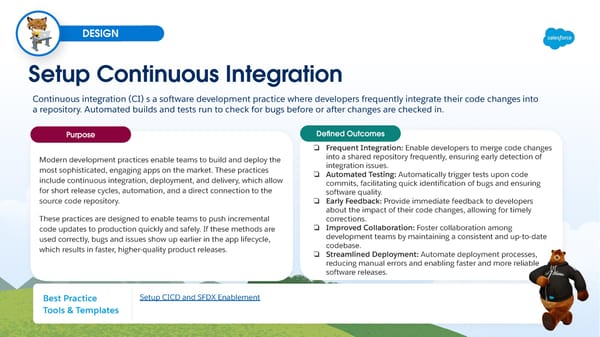DESIGN Setup Continuous Integration Continuous integration (CI) s a software development practice where developers frequently integrate their code changes into a repository. Automated builds and tests run to check for bugs before or after changes are checked in. Defined Outcomes Purpose ❏ Frequent Integration: Enable developers to merge code changes into a shared repository frequently, ensuring early detection of Modern development practices enable teams to build and deploy the integration issues. most sophisticated, engaging apps on the market. These practices ❏ Automated Testing: Automatically trigger tests upon code include continuous integration, deployment, and delivery, which allow commits, facilitating quick identification of bugs and ensuring for short release cycles, automation, and a direct connection to the software quality. source code repository. ❏ Early Feedback: Provide immediate feedback to developers about the impact of their code changes, allowing for timely These practices are designed to enable teams to push incremental corrections. ❏ Improved Collaboration: Foster collaboration among code updates to production quickly and safely. If these methods are development teams by maintaining a consistent and up-to-date used correctly, bugs and issues show up earlier in the app lifecycle, codebase. which results in faster, higher-quality product releases. Salesforce Adoption Dashboards ❏ Streamlined Deployment: Automate deployment processes, reducing manual errors and enabling faster and more reliable software releases. Setup CICD and SFDX Enablement Best Practice Tools & Templates
 A Partner Readiness Guide to Deliver Like Salesforce Page 79 Page 81
A Partner Readiness Guide to Deliver Like Salesforce Page 79 Page 81